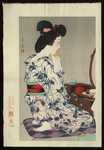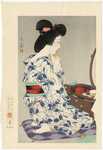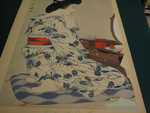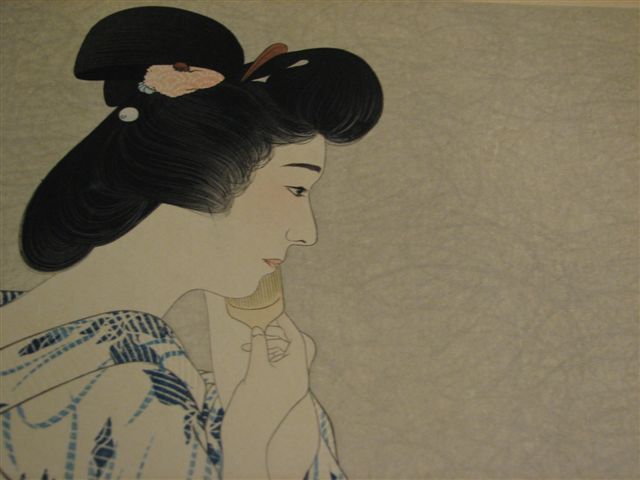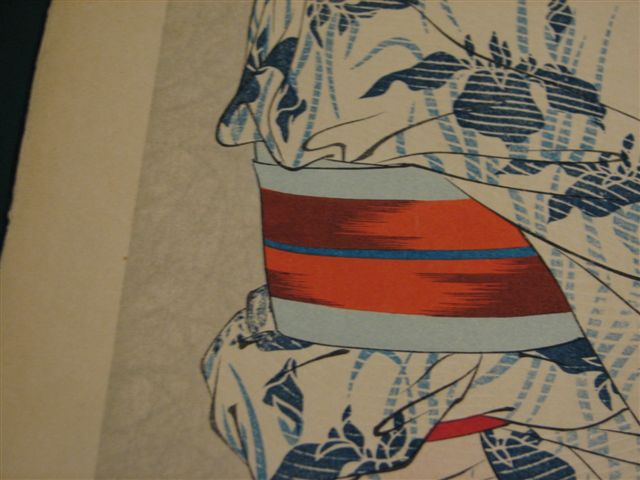| | |
| Artist: | Torii Kotondo (1900-1976) — 鳥居言人 |
| Title: | Light Summer Kimono with Irises - Ayame Yukata — 菖蒲ゆかた |
| Series: | |
| Date of first edition?: | 1932 |
| Publisher (first edition)?: | Ikeda — 池田 |
| Publisher (this edition)?: | Ikeda — 池田 |
| Medium (first edition): | Woodblock |
| Medium (this edition): | Woodblock |
| Format (first edition): | Large Oban
|
| Format (this edition): | Large Oban |
| DB artwork code: | 32091 |
| Notes (first edition)?: |
Artist Kotondo (1900-1976)
Title Ayame Yukata
Dated 1932 (confirmed. Month not yet confirmed).
Limited edition of only 100 prints, after which the blocks were destroyed.
Scene number 6 among 12 Ikeda published scenes.
Publisher Ikeda
Dimensions 19.5 x 11.5
Notes Ayame Yukata means "Cotton Kimono with Iris Pattern".
Reference: The Female Image, 2000, p. 131, pl. 176
Re-issued in the series "Twelve Aspects of Women" circa August 23, 1988.
Note: there are a lot of pre-war examples of this scene that do not have edition numbers. They are sometimes mistakenly listed as being edition 4. See my article about Kotondo edition labels here. |
|
| Notes (this edition)?: |
| The following information was taken from the original web listing of this artwork. Note that there may be some inaccuracies:
This is one of the many examples that has no edition number and no scene number hand-written on the verso cartouche.
The print has a seal on the back and text on the front below the picture. More Text is in the top left just like the one on your web site. The size of the print is 12 x 19 however, the framer must have cut at least 1/2 inch off the top and clipped the top left corner as is depicted in the picture I am sending in the next email to you. I had it framed many years ago with no knowledge of any worth of the print or I would have been very careful about who was framing it.
Thank you
Peggy |
|
| Artist Bio: |
| Torii Kotondo (or Torii Kiyotada VIII) is renowned for his paintings and shin hanga prints of beautiful women. His woodblock prints, superbly carved and printed, are comparable with those of Hashiguchi Goyo and Ito Shinsui. Kotondo was born with the name Saito Akira in the Nihonbashi district of Tokyo. He was the only son among the five children of Torii Kiyotada, the seventh Torii master. The Torii school had a long tradition of painting and printmaking for the Japanese theater, extending back to the seventeenth century. Kabuki theater was still very popular in the early twentieth century and prints and painted posters were the primary means of publicity. Although Kotondo was mainly interested in studying history and archaeology, it was assumed that he would follow in his father's footsteps and join the Torii school. At age 14, Kotondo agreed to leave school and begin studies with Kobori Tomone, a yamato-e painter. Along with painting classes, Tomone taught Kotondo about the court and military practices of ancient Japan, satisfying his interest in history. A year later, he was officially adopted as the next heir of the Torii school and assumed the artist's name 'Kotondo'. While still studying with Tomone, he began designing illustrations for a theatrical magazine, Engei Gaho ('Entertainment Illustrated Magazine'), and painted kabuki posters and billboards. Torii Kotondo was the 8th Torii and the 5th Torii Kiyotada. His father was the 4th Kiyotada.
|
|




